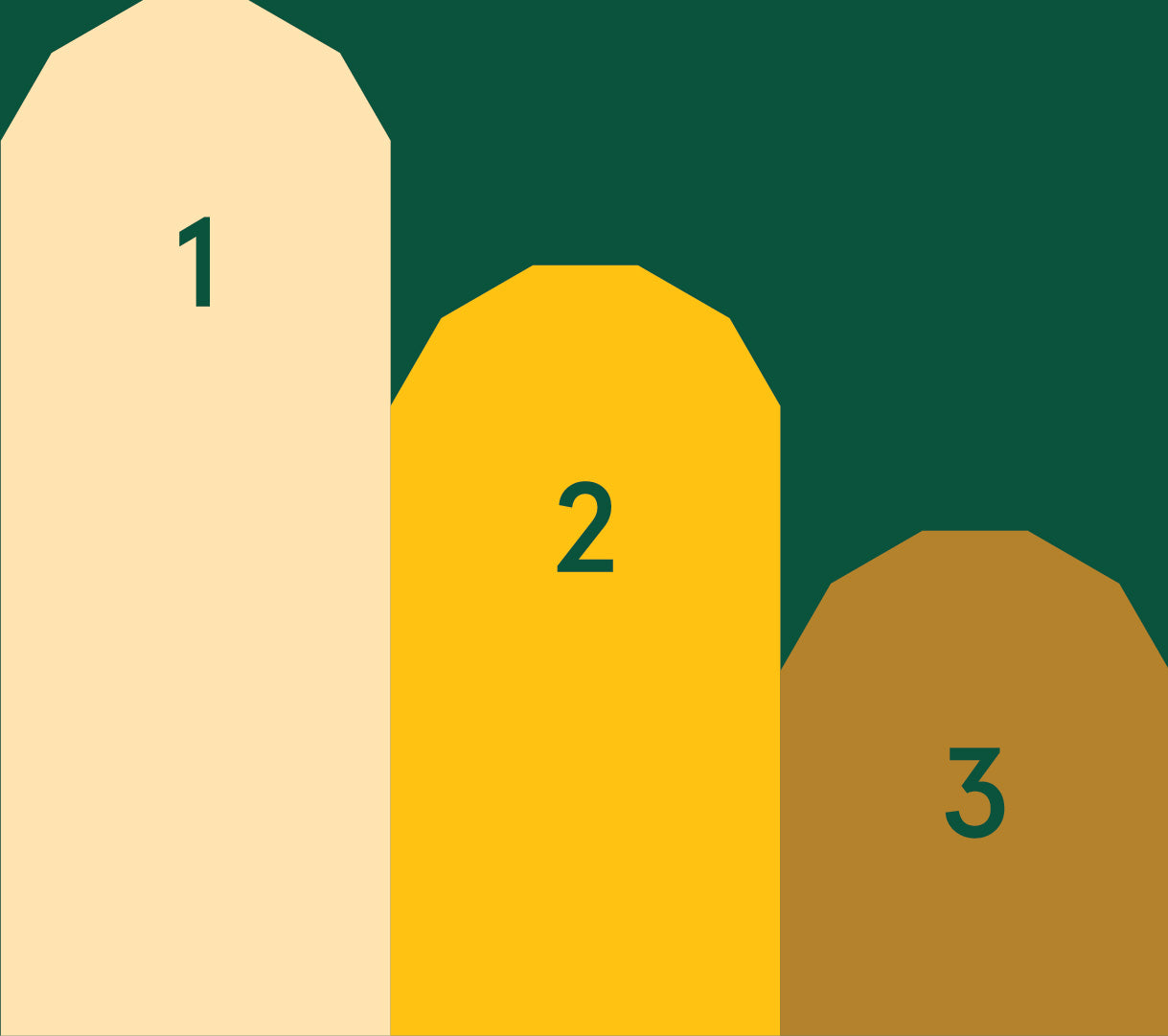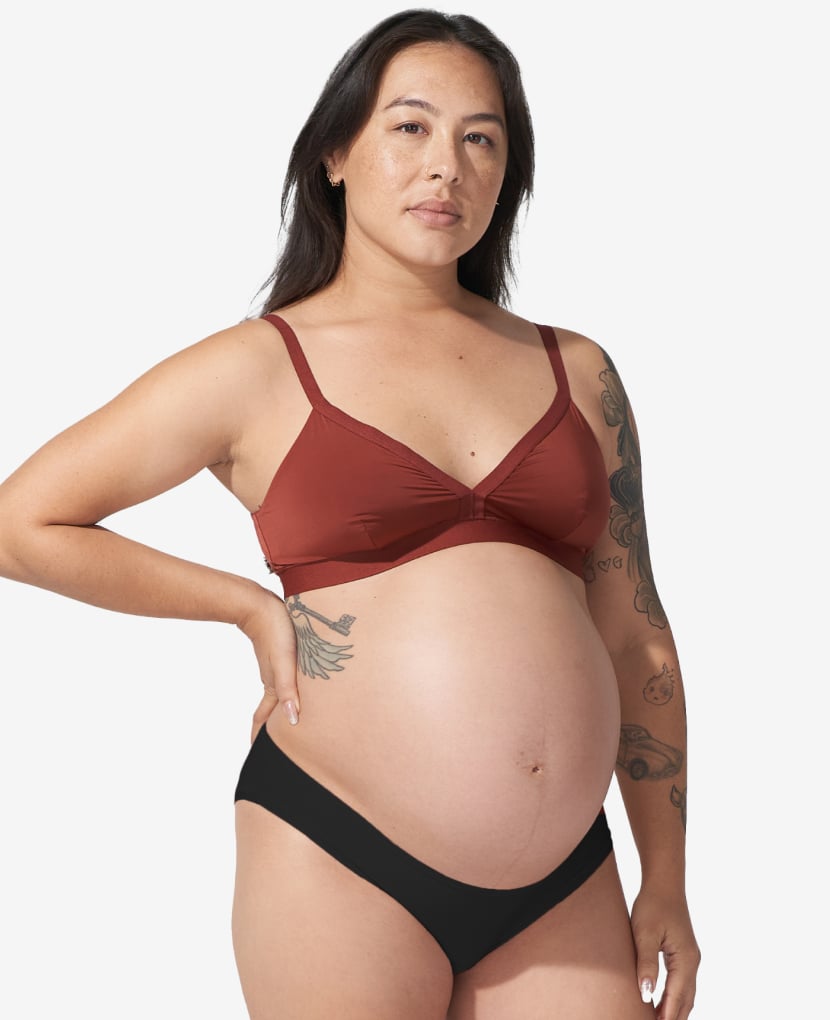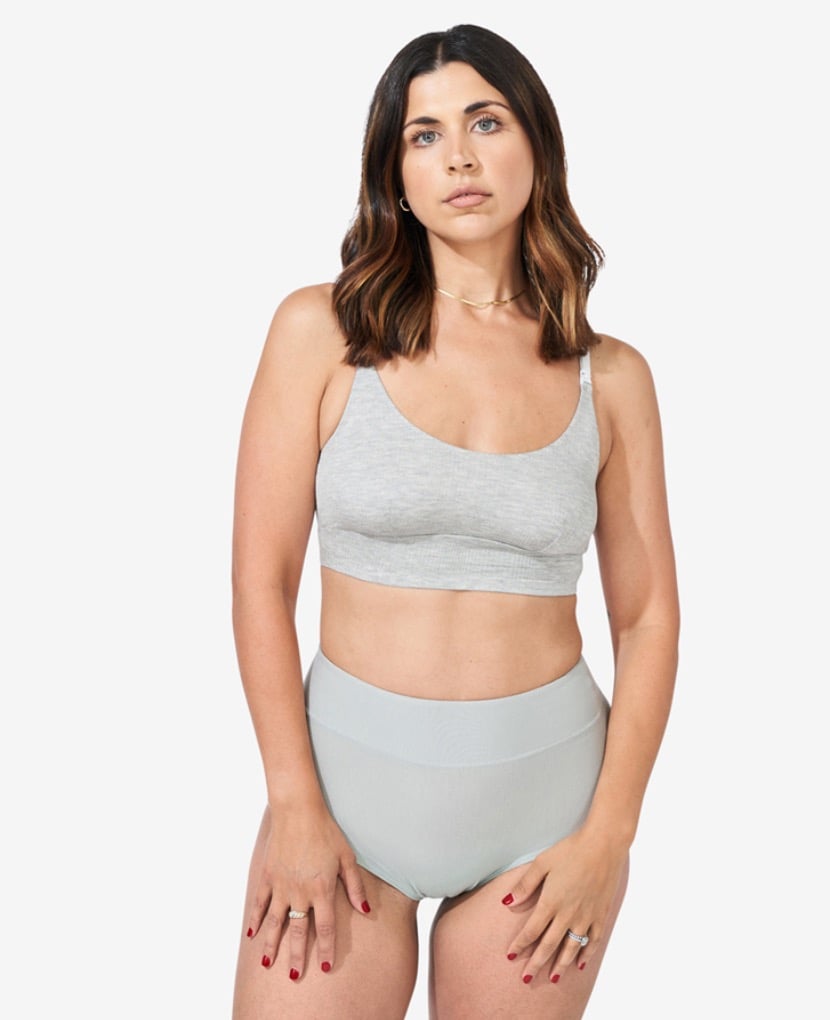The Bra You Choose Matters For Breast Health
When not breastfeeding, your breasts are pretty uncomplicated — they're primarily made up of fat and glandular tissue. But when breastfeeding, the biomechanics of the breasts become a lot more complicated. Thankfully, your body takes care of most of it for you. But there are some things that we can do to interfere with the incredible workings of the lactating breast... specifically, the bra that we choose to wear can increase risk of common breastfeeding complications such as blocked ducts and mastitis.
While the biomechanics of the lactating breast are a little complicated, choosing the right bra to optimize breast health doesn't need to be. We created a simple system to help you choose and wear nursing bras with confidence. It is as simple as 1, 2, 3: three stages of breastfeeding, and bras designed with a lactation consultant optimized for each of the three stages.
For those expectant parents who are curious about the right bra to wear during pregnancy, the answer is that it’s about your personal comfort. Until you begin breastfeeding, you don’t need to worry about blockages or other breast issues. But you may be feeling increased sensitivity, changing cup or band sizes, and wearing a non-supportive bra at night might be more comfortable for you. It is all about what feels best for you, in terms of support and shape. But do expect to change size at least a few times while pregnant so choosing a bra that grows with you, like our Everything Bra or Effortless Bra which are designed for this, can be very helpful.
Whether you're in the moment or looking to get back to you, our simple system and bras empower you to embrace the stage you're in and feel your best.
Breast Anatomy and Your Bra
The first months after delivery are when you’ll see the greatest fluctuations in your body as the breasts swell to accommodate as much milk as they can on an increasing basis. The frequently increasing quantity of milk being produced typically results in breast engorgement. The bra you wear during this time may increase or decrease your risk of common complications such as clogged ducts and mastitis.
This is because the breast is made up of tiny tubes transporting milk from the areas of the breast where milk is produced;

a tight bra or a bra with points of acute constriction can lead to blockages in these tiny tubes as milk collects from feeding to feeding. A bra that is optimized for breast health during the early and higher risk stages of breastfeeding should be minimally supportive and lacking any points of acute constriction so as not to increase risk of blockages or compress the areas producing milk (lobules) and potentially negatively impact milk production. In particular, supportive and compressive bras should be altogether avoided when you’re lactating. Stretchy bras, on the other hand, accommodate your fluctuating breasts while you're lactating and are designed to move with you.
________________________________
Stage 1: Begins at 0 Months
What to wear
During this time period for the first three months after giving birth, your nursing bra should be extremely stretchy and somewhat loose as your body adapts to increasing levels of milk production. Wearing bras that are commonly considered less “supportive” may actually reduce risk of common breastfeeding ailments, as points of constriction on lactating breasts can allow milk to coagulate, which may lead to clogged ducts. Bras with a good amount of stretch will provide the most comfort for sensitive, tender and inflamed breasts caused by frequent fluctuations in milk production throughout the day.
Characteristics of a Stage 1 Bra
These bras are designed and engineered with you in mind to maximize comfort, ease and style (like Bodily's Stage 1 Everything Bra). The key things to look for are maximum stretch, no points of constriction, full breathability of fabric, and the ability to launder frequently.
Elastic in all directions
From the underside of your breasts, which become heavy and tender due to gravity, all the way to the sides, your bra should stretch to accommodate the growing and often engorged milk-producing areas of your breasts.
Ultimate breathability
Because we tend to sweat more and differently in the postpartum period.
Easy to wash and dry
Nursing in Stage 1 can be messy. As much as we might live in pajamas during this stage, it is important to keep your bras clean and protect against bacteria building in the fabric from dried milk collection. Wearing breast pads (and changing them regularly) is another good strategy for keeping your nursing bra free of bacteria.
Easy access for nursing
Easy and fast access for breastfeeding eases the urgency of frequent and round-the-clock feeding.
Has no acute points of constriction anywhere
Skip the underwire, push-ups, firm molded cups, and sports bras completely in this stage. These elements can increase risk of common breastfeeding ailments that are often the cause of the early cessation of breastfeeding— approximately 60% of those who stopped breastfeeding did so before they desired.
Stage 1 FAQs
When to wear it
When you’re in your first three months, you can wear your Stage 1 bra as much as you’d like, which includes all day and all night. This period of time is the most at-risk period and your Stage 1 bra is optimized for breast health.
Why it’s necessary
The first months after delivery are when you’ll see the greatest fluctuations in your body as the breasts swell to accommodate as much milk as they can on an increasing basis. The frequently increasing quantity of milk being produced typically results in breast engorgement. The bra you wear during this time may increase or decrease your risk of common ailments such as engorgement, clogged ducts and mastitis.
What if I need to wear a bra with more support?
You can wear a Stage 2 bra during Stage 1 if you want to feel a little more like your old self or a Stage 3 bra if you have a special event to attend — but for no more than 3 hours consecutively. Note that anything with a firm molded cup or underwire will be uncomfortable, given the speed at which milk moves through the lactating breast. Any restriction, like a firm molded cup or underwire, could potentially constrict that movement and compress breast tissue, causing milk to coagulate and a duct to become blocked. Stage 1 is where common breast ailments arise due to pooling and inflammation — and wearing a Stage 3 bra in particular during Stage 1 adds more risk at a time when paying attention to breast health is paramount. If you are opting to wear a Stage 3 bra during Stage 1, you should return to your Stage 1 bra after 2-4 hours and wear it consecutively for 24 hours (including sleep) to offset any effects of your more restrictive Stage 3 bra. Going bra-free ultimately is the best thing for your breasts from a health optimization perspective.
Can I wear my Stage 1 bra beyond the first three months?
The Stage 1 bra is most optimized for breast health, so wearing it at any time, while lactating or not, is great for your body. Once you progress beyond the first three months, you may choose to continue to wear your Stage 1 bra during the day because of its comfort and ease, but it is most important to continue to wear your Stage 1 bra through the night.
What do I wear at night?
The golden rule for bras’ contribution to optimal breast health while lactating is to wear your Stage 1 bra at night no matter what stage of breastfeeding you’re in — that is, if you choose to wear a bra at all. Going bra-free ultimately is the best thing for your breasts, although many people opt to wear a sleep bra due to nipple sensitivity, leaking breasts, or other reasons related to comfort.
________________________________
Stage 2: Begins at 3 Months
What to wear
While your breasts are still fluctuating 3-6 months postpartum, these fluctuations are typically less extreme than those in Stage 1, so the risk of experiencing common breastfeeding ailments is slightly reduced. This means you can introduce a slightly more supportive bra, although it is critical that it is still stretchy with good elasticity. While you may be itching to return to your old bras, it’s not quite time yet.
Your breasts become more accustomed to producing milk during this time and are doing so more effectively now. Mornings are when the breasts are typically most full (before nursing), and while stretchy bras do accommodate these fluctuations, it is important to nurse or pump before putting on your Stage 2 bra and heading into the day. There is no issue with continuing to wear your Stage 1 bras during Stage 2, particularly at night.
Characteristics of a Stage 2 Bra
Stage 2 Bras, like our So Easy Bra and Back-At-It Bra, reintroduce support while still prioritizing stretch and are designed to combine both comfort and functionality. These bras are not meant for 24/7 wearing, rather to complement your Stage 1 bras for when you want to wear a bra that feels more like your non-breastfeeding bras. They have just a bit more structure, the fabric doesn't have to be all-natural and they can even have a soft foam lining.
Slightly more supportive than a Stage 1 bra
People tend to experience engorgement less frequently in Stage 2 (typically with the exception of the morning), which allows for a little more support during the day. As breasts fill and then empty throughout the day, size and swelling tends to fluctuate, which is the reason a good amount of stretch is still important. Wearing a tight-fitting or overly supportive bra can still increase the risk of common breastfeeding ailments, which are typically encountered slightly less often during this time (less than 30% report breastfeeding pain by two months, vs. close to 50% who do so during the first month).
Not a push-up, underwire, firm foam cup, sports bra, or otherwise compressive bra
A tighter-fitting bra or one with an underwire can be worn at this stage (for a special occasion, for example) but infrequently and only for brief periods of time (under 3 hours) and not before you’ve pumped or breastfed in the morning. Throughout the day, it is advised to release milk every 2-4 hours, whether through pumping, nursing or expressing. This, along with switching back to non-supportive bras, will help alleviate risk of clogged ducts.
Stretchy
The stretch of a Stage 2 bra accommodates periodic engorgement and fluctuating levels of fullness throughout the day, and provides support without being too restrictive. Stretch also mitigates against common breastfeeding ailments (e.g. engorgement, clogged ducts, mastitis) when wearing a more tight-fitting bra may increase, rather than reduce, risks of these conditions.
Easy access for nursing
As the interval of time from one nursing or pumping session to another tends to decrease during this stage relative to this first few weeks, opting for a pull-down vs. a clip-down is a matter of preference. Nursing clips may feel more viable for many people than it did in the months prior, as seen in the Back At It Bra, but some may prefer the ease of a pull-down in the So Easy Bra.
Stage 2 FAQs
When to wear it
At night you should always go back to a Stage 1 bra as it is optimal for breast health. In addition to resetting your breasts after a full day in a Stage 2 bra, the overnight period is typically when breasts are most full in Stage 2. Any time that your breasts are full and approaching engorgement, a Stage 1 bra provides the most protection and is recommended.
Why it's necessary
People typically experience engorgement less frequently in Stage 2 (generally with the exception of the morning). However, the quantity of milk the breasts produce still tends to increase during this time, resulting in size fluctuation and periodic swelling. Common breastfeeding ailments (clogged ducts and mastitis) are still a risk in Stage 2. For people continuing to breastfeed while returning to work, the risk of these ailments can increase if a pumping schedule isn’t adhered to closely and breasts become engorged. While you can move to wearing a more supportive bra in Stage 2, the right bra will still have adequate stretch, no underwire and no firm foam cups — thereby helping to maintain optimal breast health and keep risk of ailments lower.
What if I need to wear a bra with more support?
Like in Stage 1, you can wear a more supportive bra (if you have a special occasion for example) when you’re in Stage 2 if you confine it to a brief interval of time and do it infrequently. Specifically, no longer than 4 hours in a day during the first three months. It is not recommended to wear underwire bras until Stage 3. If you opt to wear Stage 3 bra for any time during this period, we recommend that you change back into your Stage 1 bra for the rest of the day and night to realign to optimal breast health.
What do I wear at night?
The golden rule for bras’ contribution to optimal breast health while lactating is to wear your Stage 1 bra or nothing at night no matter what stage of breastfeeding you’re in.
________________________________
Stage 3: 6 Months and Beyond
What to wear
You can welcome back more supportive bras (like The Do Anything Bra), and if desired, that include features that lift and shape (like a molded cup), but for only up to 6 hours at a time (while making sure to release milk every 3-4 hours).
Characteristics of a Stage 3 Bra
A Stage 3 bra that prioritizes lactating breast health can incorporate more supportive features, such as:
Soft foam cup for support, lift and shaping (if desired)
It can be difficult to nurse using a firm foam cup, so many opt for a soft foam cup if you are looking for increased support, lifting and shaping.
Underwires in limited duration
Because underwire tends to lift and shape in a more extreme way, pushing and compressing breast tissue and potentially causing acute points of constriction, wearing bras with this feature in particular should be limited to 6 hours per day, and the effects of wearing an underwire bra should be offset by wearing a Stage 1 bra for the remainder of the 24-hour period.
Stage 3 FAQs
When to wear it
You can wear these bras for up to 6 hours — with the time to remove milk in the 3-4 hour range — after hitting the 6-month mark. A Stage 2 bra (or a Stage 1 bra) can still be worn all day during this stage.
Why it’s necessary
At this stage, you’re less likely to have issues such as clogged ducts, mastitis, and engorgement, so the need to reduce compression and constriction on lactating breasts is reduced. However, it is not gone entirely. Overnight remains the time when breasts become the most full, so maintaining good breast health habits at night in particular remains essential. For some, more support may be desired due to breasts becoming more pliable and losing their initial postpartum density, and at this stage that can be accommodated by wearing a more supportive bra in 6-hour blocks.
What do I wear at night?
The golden rule for bras’ contribution to optimal breast health while lactating is to wear your Stage 1 bra or nothing at night no matter what stage of breastfeeding you’re in.
________________________________





-v1694112927642.jpg?830x1020)


